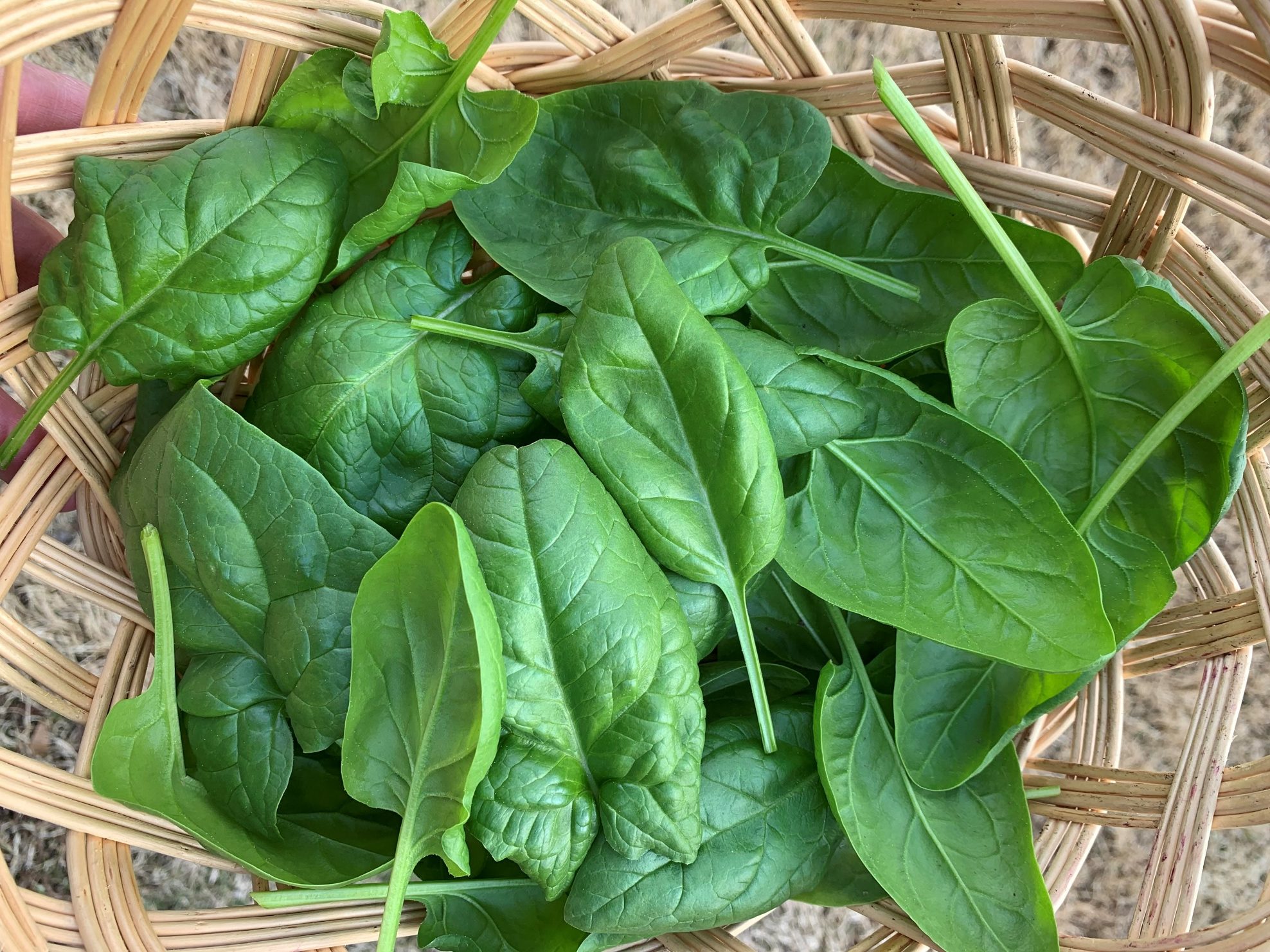Spinach has been around since antiquity. Originating in Persia, this leafy green was introduced to India, where it was then acquired by the Chinese in about 647 A.D. and given the name the Persian vegetable. It wasn’t until the 14th century that Spain introduced it to England and France. Spinach grew even more in popularity when the 16th-century queen of France, Catherine de’ Medici, demanded that it be served at every meal. As a result, dishes made with spinach are known as Florentine because the spinach-loving queen was born in Florence .[1]
Spinach is a member of the Amaranthaceae family, and a cousin, if you will, to beets and Swiss chard. It is packed with iron, calcium, antioxidants, vitamins A, B, C, and K.
This article contains affiliate links. If you make a purchase using one of these links, I will receive a very small commission at no additional cost to you, and it will help me maintain this website. Rest assured, I only recommend products I actually like!
How to Plant
Spinach is one of the fastest growing crops in the garden. It can be grown in both the early spring and in fall, which makes it an ideal choice for those in hardiness zones 3 through 9.
Spinach is a cold-weather crop, meaning that it does not tolerate heat. Established plants can survive temperatures as cold as 15°F (-9 C), especially if planted in a cold frame or under a row cover. However, they prefer temperatures between 35°F and 75°F (1°C and 23°C).
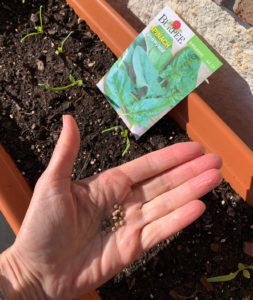
Spinach grows best in well-drained, organic soil with a pH of at least 6.0 and ideally between 6.5 to 7.5. If you are unsure of the pH level of your soil, you can easily test it yourself. This is the kit that I use. Because spinach is considered a heavy feeder, you will need to amend the soil with compost or a balanced fertilizer before planting.
Plant seeds about a 1/2 inch into the soil and 3 to 4 inches apart. Cover lightly with soil. Keep the soil moist but not soggy during the germination process. Sprouts should emerge between 7 and 14 days. If you find the seeds are slow to or fail to germinate, try soaking them in warm water for several hours. This process is called seed scarification. You can learn more about this process in this helpful article.
Do not overcrowd the plants as this can diminish air circulation and promote disease. If necessary, thin seedlings once they are 2 to 3 inches tall. Succession plant every two to three weeks for a continual harvest.
If you are planting in a container, you can plant approximately 6 or 7 seeds in a container that is about 12 inches in diameter and about 6 inches deep. If you are using the Square Foot Gardening method, you can plant 9 seeds per square foot.
Spring and Fall Planting
In the spring, start seeds indoors under a grow light 6 to 8 weeks before the last spring frost. If you are unsure of your frost dates, you can find a helpful link in my Resources section under Helpful Gardening Links. Or, direct sow as soon as the soil is easily worked and the daytime temperatures are at least 50ºF (10ºC). Younger plants are more susceptible to cold weather, and you may have to cover them if the temperature drops.
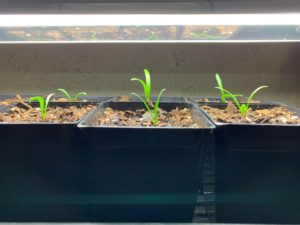
If you live in a warmer climate, you may be able to extend the spring growing season by using a row cover or partial shade cloth to protect the plants from warming temperatures. Alternatively, you can try planting spinach next to other plants that can provide shade once they mature. Typically, temperatures 80ºF and above will cause the plant to bolt (produce seed), and the leaves to turn bitter.
For a fall crop, direct sow seeds 6 to 8 weeks before the first frost date. If you start too early, the soil may be too warm for the seeds to germinate. Spinach is one of the more cold-tolerant crops, but the plants need to be established before the cold arrives. You can use a cold frame or row cover to protect young seedlings if needed. The plants will become semi-dormant once gray skies set in. So, unlike a spring crop, you will need to water less and stop fertilizing it. But once temperatures begin to warm with the increase in daylight, they will be reactivated. Some varieties are more cold-tolerant than others (see below) so plant accordingly.
Spinach makes a good companion for a wide range of plants including, celery, cauliflower, eggplant, corn, strawberries, cabbage, kale, radishes, peas, Brussels sprouts, asparagus, dill, and onions.
Sun, Water, and Fertilizer
Spinach needs six hours of full sun to grow. Once the plants are well established, they may be able to be maintained with five to five and half hours of sunlight, although their growth will be slower.
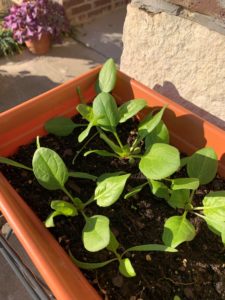
Spinach plants prefer moist soil that drains well. Do not overwater as this can promote disease. If you are growing in containers, you will need to water them more frequently as the soil in containers tends to dry out quicker than in ground gardens. Adding mulch to containers or beds can help maintain moisture.
Like other leafy greens, spinach thrives on nitrogen. Compost or compost tea, blood meal, and fish emulsion are excellent sources of nitrogen. You can also apply a balanced fertilizer, a 10-10-10, for example. Be sure to follow package directions on all fertilizer applications.
Pests
Unfortunately, you are not the only one that loves spinach. There are a number of garden pests that love it, too!
Aphids are very small, soft-bodied insects that hide on stems and the undersides of leaves. There are numerous varieties of aphids that come in different shapes and colors. Although they are tiny, they pose a threat to any garden because they suck the sap out of your plants, and they can spread viruses. They are perhaps best known for the sticky substance they secrete called honeydew. This sweet residue can promote the growth of black sooty mold. What’s more, ants feed on the honeydew and, in turn, protect the aphids from any threats posed by predators. You can learn more about this common garden pest and how to get rid of it in this article.
Leaf miners are one of the more common pests that will damage your spinach plants. The term refers to the larval stage of a variety of moths, wasps, beetles, and flies that lay their eggs on the leaves. Once the eggs hatch, the microscopic larvae will tunnel into the layers of leaf tissue where they will “mine” for sap. Squiggly, erratic lines on the leaves are a telltale sign. Learn more about this pest and what to do in this article.
Flea beetles are little insects that eat small wholes in spinach leaves. They can do considerable damage if left unchecked. You can learn more about flea beetles and how to effectively treat them in this article.
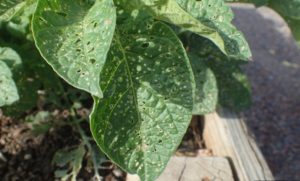
Cutworms are the larval stage (i.e., caterpillar stage) of night-flying moths. They come in a variety of colors and are usually no more than 2″ long. They typically come out at night to feed on lettuce, Swiss chard, and other greens. They will eat the leaves and also the stems at or near the soil level. During the day they hide in the soil by curling up in a “C” shape.
You can deter cutworms by placing cardboard collars made from paper towel or toilet paper tubes, around the base of the plants, making sure it extends into the soil. In addition to removing the caterpillars by hand, other effective methods include sprinkling abrasives such as diatomaceous earth or eggshells around the plants. These will scratch the cutworm, causing it to die. You can also apply cornmeal, which when eaten, will affect their digestive tract. If they eat enough of it, they will die. Learn more about cutworms in my article, How to Identify and Get Rid of Cutworms.
Cabbage Loopers are the larval stage of a nocturnal moth. These small caterpillars move in inch worm fashion causing their bodies to loop. In addition to cabbage, these destructive pests like a host of other plants like beets, celery, cucumbers, Brussels sprouts, and, of course, spinach. You can learn more about them and how to get rid of them in this article.
Diseases
Pests are not the only thing you will need to keep an eye out for. Spinach is prone to certain diseases as well.
Mosaic Virus is characterized by discolored spots on the leaves that vary from light green to yellow to sometimes white. Affected leaves are sometimes said to have a mottled appearance. This virus stunts the plant’s growth and cause the produce to be inedible. Unfortunately, there is not much you can do to save the plants. You will need to pull the infected ones from your garden so that the disease does not spread. Do not compost the plants. You may also want to opt for growing a variety that is resistant to the virus.
Downy Mildew is a pseudo fungus that first appears as a gray to bluish-white fuzz on the underside of leaves followed by yellow spots that develop on the upper side. When the leaf spots die, the mildew will darken. Downy mildew is sometimes confused with powdery mildew.
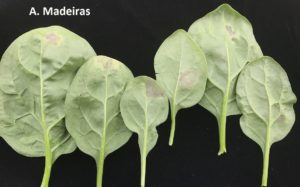
Neem oil is the best organic method for treating downy mildew. It will not cure it, but it can control it if caught early. This is the neem oil I use. Follow the manufacturer’s directions. Some choose to treat a more severe infection with a copper fungicide, however, I prefer not to use this treatment. Remove infected plants and throw them away. Do not compost them.
To lessen the chances that your plants will get downy mildew, properly space them when planting so that there will be adequate air circulation between them. Also, be careful not to get the leaves wet when watering. Damp leaves and poor air circulation can be an invitation for disease. It may help to employ a drip irrigation system.
Fusarium Wilt, also called damping off, is a soil-borne fungus that affects primarily nightshades but can also be a problem with spinach. Fusarium wilt can keep seeds from developing, or it can impact later stages of development by restricting the plant’s ability to take up water, eventually causing it to wilt. This article provides more information about this disease and what you should do if your plants have it.
White Rust is sometimes confused with downy mildew because of the yellow to white spots that are visible on the upper side of leaves. The underside, however, will contain white blisters or bumps, unlike downy mildew. As the disease advances, the blisters may turn a rust color. White rust on spinach will also cause severe wilting. In the early stages, it is possible to treat by removing infected leaves. However, once the plant develops reddish-brown blisters or shows signs of wilting, it must be destroyed to prevent further spread.
White rust often occurs in cool, humid conditions. To promote air circulation and a drier environment, allow the proper amount of spacing between plants. The best treatment for white rust is prevention.
Harvest
Spinach is a fast growing crop. Depending on the variety, it takes 30 to 50 days to reach maturity. Like lettuce, you can harvest spinach in a cut and come again method by removing the outer leaves at the base so that the plant will continue to grow and produce more leaves.
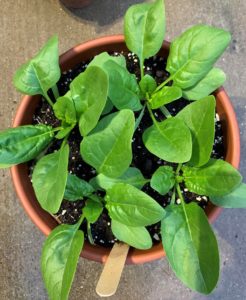
Wash and dry the leaves before placing them in a plastic bag or similar container. It should keep in the refrigerator for several days. You can also blanch it and store it in the freezer. It is also possible to can spinach in a pressure canner for an even longer shelf life.
Spinach makes a great addition to salads, pasta, smoothies, and soups. Here is one of my favorites recipes, Spinach, Cucumber, and Basil Soup.
Spinach Varieties
Spinach varieties fall into one of three categories: flat leaf, semi-Savoy, and Savoy.
Flat Leaf spinach’s smooth appearance is hinted at by its name. This type of spinach is usually the type that is found in most grocery stores. Many flat leaf varieties, like Seaside, Lizard, and Woodpecker, are slow to bolt and ready to harvest in about 30 days. Matador and Giant Nobel are popular options, while Seaside, Lizard, and Woodpecker are slow to bolt.
Savoy is a hardy, cold-tolerant spinach that is easily recognized by its wavy or crinkled leaves. This type lasts longer in the refrigerator and contains less oxalic acid than flat leaf varieties. One downside to this type is that it can be a bit more challenging to clean because dirt tends to hide in the folds. Soaking the leaves in cold water followed by rinsing will help to dislodge any debris.
Savoy varieties include Bloomsdale, Bloomsdale Long Standing, Hammerhead, and Winter Bloomsdale, which is said to be more resistant to mosaic virus.
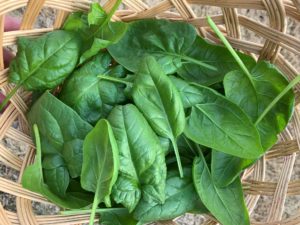
Semi-Savoy spinach is also hardy but less crinkled than Savoy. Some varieties are more disease and bolt-resistant than Savoy. Acadia, Kolibiri, and Reflect are varieties that are slow to bolt, while Tyee is resistant to downy mildew.
If you are looking for heat resistant varieties, you may want to consider New Zealand and Malabar. New Zealand spinach has succulent-like triangular leaves and is best eaten raw as it can become mushy when cooked. Malabar, while not a true spinach, can be used in place of traditional spinach. The plant’s vines can be directed to grow up a trellis to save space.
Spinach is such a quick, easy, and rewarding crop to grow. Including it in your fall-winter or early spring garden will provide you with a nutritious and delicious harvest to enjoy as you wait for warmer days.
Thank you for reading this article! If you found it helpful, please consider sharing it with others via email or social media!
[1] Vegetable Facts, http://www.vegetablefacts.net/vegetable-history/spinach-history/
